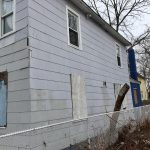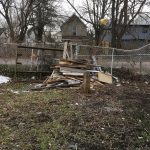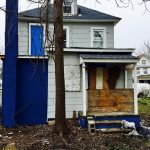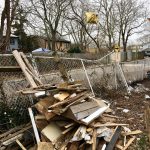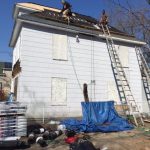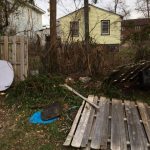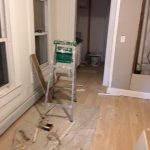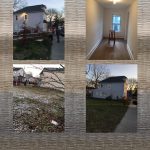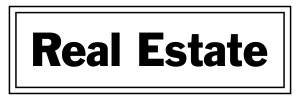City Property Maintenance Code Violations At Issue
Snapshot Of How New Laws Will Affect Residents & Land Owners
Since 2001, a Brooklyn based property owner of three lots on Avenue A has received property maintenance violations from the city’s code enforcement department, according to city records.
With a goal of utilizing two of the three lots for urban farming and the third as part of a an affordable housing project that will help rehabilitate residents living on the fringe, little has been done in the 15 years to move its development forward.
What has been a constant – the countless property maintenance violations accrued, according to according to Director of Property Improvement and Neighborhood Preservation Robert McKeon.
- Ave A Property From City
- Ave A Property From City
- Ave A Property From City
Today, the adoption of new Property Maintenance Code will help address repeat offenders who have often skirted local laws and the ability to enforce them.
The property owner Eva Arnold has since transferred ownership to an LLC, and continually shows up the day before a scheduled court appearance only to say she cannot attend court the following day because she lives miles away, McKeon said.
- Ave A Property From City
- Ave A Property From City
- Ave A Property From City
“We [a grassroots group of area residents] have been trying to rehab in the western part of Asbury Park,” Arnold said in a telephone interview.
Arnold, an artist by trade, said she lived for seven years on the property she bought in 1994 via foreclosure. With a limited budget, she has done ad hoc projects to refurbish the existing homes and wants to start a construction workforce development program that would give the city’s youth a chance to learn a new trade alongside construction professionals as new affordable homes are built, resulting in the apprentices building the final home on their own with professional oversight.
- Ave A Property From Owner
- Ave A Property From Owner
- Ave A Property From Owner
But her application for tax exemption was denied by city tax assessor Eric Aguilar because it does not meet the requirements. Arnold is appealing his decision, he said.
“It’s one of the biggest scams I’ve ever seen,” Aguilar said of the submitted application and its details.
Arnold said it is no scam and that she went the tax exempt route in order to help manage the expenses associated with maintaining and refurbishing the land. Among the violations, she’s accrued is a $6,000 fine she appealed and won in part.
- Ave A Property From Owner
- Ave A Property From Owner
- Ave A Property From Owner
“We are all volunteers working with no budget or funding,” Arnold said.
As for the 3 x 8 foot wood pile, that sparked the recent violation, Arnold said she needs it for ongoing construction projects.
But in moving from its 1996 property maintenance code known as BOCA to the International Maintenance Code, city officials have implemented changes that allows them to better address a host of issues like this one plaguing the city, McKeon said.
- Ave A Property From Owner
- Ave A Property From Owner
- Ave A Property From Owner
“Essentially it provides our inspectors with much more authority and discretion in addressing property maintenance violations, as well as issues that we have with problem properties owned by slumlords and absentee landlords,” McKeon said. “This new Property Maintenance Code applies more stringent standards and it finally allows us the ability to seriously address recurrent problem properties, by bringing those property owners to Court in a more expedited fashion.”
In recent years, city officials have sought to address the lack of maintenance to abandoned buildings and the substandard living conditions allowed to exist by absentee landlords but the municipality’s outdated property maintenance code left little in the way of addressing the violations that were specific to the city.
- Ave A Property From Owner
- Ave A Property From Owner
- Ave A Property From Owner
“The former BOCA code required issuance of Notices of Violations for basic, common sense violations that directly affected health, life safety and residents’ welfare issues,” McKeon said. “That requirement essentially equated to our department taking on the role of custodians, requiring us to first advise property owners of fundamental, apparent and very conspicuous property maintenance violations, before we could take formal legal action to obtain compliance.”
The new code was adopted at the Dec 28 Council meeting and became effective on Jan 17, resulting in the recent spike in violations because it allows for the automatic issuance of summonses without notices of violation.
“It lets us get right to problem,” McKeon said. “A violation is a violation is a violation. The goal of code enforcement in any municipality should not be to focus on collecting fines from property owners, but rather to obtain compliance, thereby improving the quality of life for all of the residents.”
- Ave A Property From Owner
- Ave A Property From Owner
- Ave A Property From Owner
McKeon said, in many instances compliance is only accomplished after a summons is issued, as many residents either ignore or do not take Notices of Violation seriously. He estimates that 30 percent of city property owners are among the worst offenders who ignore the property maintenance laws and violations issued by the four member [three full time] code enforcement employees.
“If, in the discretion of the code enforcement officer or myself, there is an issue or violation that affects the health or life-safety concerns of residents or neighbors in the area, then we will immediately address the problem and issue a summons,” he said.
Once a summons is issued, authority reverts to the municipal prosecutor who then determines, based on McKeon’s department’s recommendation, the applicable violation charge.
- Ave A Property From Owner
- Ave A Property From Owner
- Ave A Property From Owner
“If it’s a first offender and if between the issuance of the summons and the day of court, the property owner addresses the violation, we will recommend the minimum fine,” McKeon said. “We are not looking to collect fines, we are looking for people to comply.”
Fines range from $66 to $2150 plus $33 court fees. Tor view the updated Property Maintenance Code in its entirety click here.
Violations that will now garner automatic summonses include:
Failure to provide Required Utilities (Water)
Failure to provide Required Utilities (Electric and Heat)
Failure to obtain a Certificate of Occupancy before Occupancy or Transfer of Title prior to closing of title
Trash at curb on days when pickup is not scheduled and not in compliance with the Solid Waste chapter of the City Code
Failure to provide proper Snow removal
Prohibited occupancy of a placarded structure
Sanitation (exterior property and premises to be maintained clean and sanitary)
Grass, Weeds and plant growth in excess of 10 inches
Accumulations of garbage or rubbish
Failure to provide clean, sanitary disposal of rubbish in a container
Failure to provide clean, sanitary disposal of garbage in a container
Overcrowding
Occupying non-habitable spaces for sleeping purposes
Failure to maintain a safe, unobstructed means of egress
Accumulations of trash, rubbish or other materials blocking egress
Tampering with a smoke or carbon monoxide detector
Failure to provide operable smoke and carbon monoxide systems at all times
Any other items or violations deemed compliant with this section, which, in the discretion of the Code official or officer, affect the health or safety concerns of the citizens.
——————————————————————————-
Follow the Asbury Park Sun on Facebook, Twitter and Instagram.
The Asbury Park Sun is affiliated with the triCityNews newspaper.



